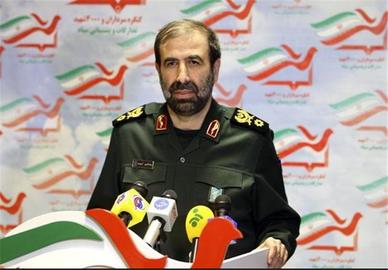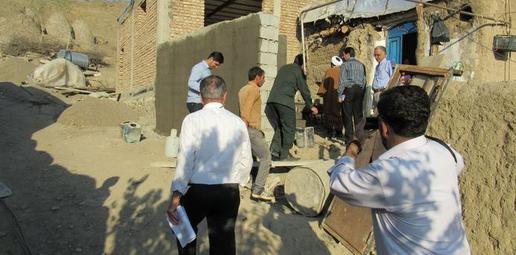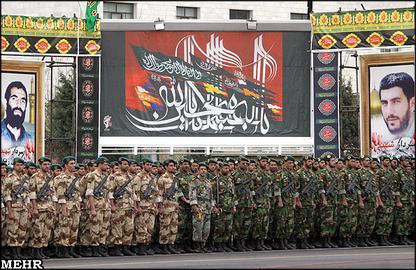The Revolutionary Guards: An Introduction
The Islamic Revolutionary Guard Corps (IRGC) is the Islamic Republic of Iran’s most important institution. The military-security institution commands huge influence in every aspect of Iranian public life, from culture and the environment to the economy, politics and judicial process. Whatever the field or area, the IRGC is not required to report to anybody and is answerable to no one.
The IRGC was created early after the 1979 Islamic Revolution by the order of the founder of the Islamic Republic, Ayatollah Ruhollah Khomeini. Its declared mission was to safeguard the revolution and its accomplishments. As the years have gone by, it has expanded its sphere of activities. The entities under its control have multiplied to such a degree that it now operates effectively as a parallel government. It interferes in all current affairs of the country and it aims to have control over every aspect of the way Iran is run.
In a series of reports, IranWire presents a detailed portrait of this powerful and mysterious institution and, for the first time, identifies and explains all bodies, institutions and other entities operating under the umbrella of the Revolutionary Guards, at the same time outlining its activities through an infographic and an interactive diagram.
The infographic is a visual representation of the Guards’ organizational structure and presents all institutions under the control of IRGC in one map. It resembles a family tree, a portrait of the IRGC with all its children, grandchildren and great-grandchildren — a dramatic picture of power in Iran today.
In the interactive diagram, the viewer is able to use the mouse to see how various entities under the control of the Guards emerged, and how they are connected — exactly like a family tree.
IranWire has aimed for this series and the overall project to be informative and a solid research tool. But it is not perfect, and there will always be room for updates, enhancements and further information. We welcome your views, ideas and knowledge, so please do get in touch via email, Twitter or Facebook.
***
Training and Excellence Headquarters: (Gharargah-e Tarbiyat va Ta ‘ali)
The Training and Excellence Headquarters is a subsidiary of the training divisions of the IRGC. This headquarters is tasked with reforming the training staff processes. To this end, in 2009, the training division of the IRGC announced the implementation of reforms in the headquarters in six important areas. The areas include criteria for suitable IRGC recruits, the organizational and guardianship culture, removal of unnecessary training, and reform in training staff processes, which is being carried out as a comprehensive review of educational and training topics. These include a review of planning and implementation of seminars, a review of the behaviors of commanders and managers towards the soldiers, assessing the Nasehin program, producing entrepreneurial and published proposals for the aforementioned program, and the management of the physical training programs for the IRGC and the Basij in all provinces.
Progress and Development Headquarters: (Gharargah-e Pishraft va Abadani)
Progress and Development Headquarters is a new entity that was established in October 2016 by order of Supreme Leader Ayatollah Ali Khamenei. Its most important mission is “development and progress of the less fortunate regions in the country, creation of jobs, and improvement of culture and sanitation in those areas.” The reason behind the establishment of the headquarters is “to execute the Supreme Leader’s wishes and commands, and to repeat the success story of Khatam-al-Anbiya Construction Headquarters in every province.”
Accordingly, the headquarters in each province act as an extension of the Khatam-al-Anbiya Construction Headquarters and take on some of the regional tasks as their own.
Another task the headquarters undertakes is to organize some of the other IRGC-related affairs in each province, such as organizing the jihadi camps which, was previously the responsibility of the Students’ Basij.
Progress and Development Headquarters: Command and Structure
The branches of Progress and Development Headquarters in each province are under the supervision of the province’s IRGC. The IRGC commander in the province also appoints the head of each branch. Every province has a council that consists of the governor of that province and his assistants. The councils are in regular contact with the province’s headquarters for planning and execution of different projects.
Progress and Development Headquarters: Operations
Creating employment opportunities, poverty alleviation, job creation, sanitation, and cultural programs are the major tasks assigned to the headquarters. In the first phase of operations, the headquarters has planned a development program to be carried out in 10,000 villages across the country. According to the plan, each village will have its own foundation and will receive a two-billion Iranian rial loan with no interest.
Progress and Development Headquarters: Jihadi Nuclei
As a part of the national program, the headquarters designed the Jihadi Nuclei (Hastehayeh Jahadi) to be established in villages. Each nucleus operates in coordination with the province headquarters and has joint meetings with the province’s construction Basij, resistance economy officials, and the IRGC commanders in the region.
Poverty Alleviation Headquarters
(Gharargah-e Mahroomiat Zodaee)
The IRGC Poverty Alleviation Command Headquarters was established in 2014. The head of the center is the chief commander of the IRGC, and his deputy coordinator is the command center’s director. The command center’s members are: the IRGC Navy, Aerospace and Ground Forces, Medical and Engineering Divisions, Cooperative Credit Union, and the Khatam-al-Anbiya Construction Headquarters, which acts as the executive wing of the center. Ongoing poverty alleviation projects take place in the provinces of Western Azerbaijan, Kurdistan, Kermanshah, Ilam, Sistan and Baluchestan, Hurmozgan, and Bushehr, focusing on the poorest and most remote villages. Some of these projects include building public restrooms, mosques, housing units, clinics, schools, water treatment plants and mortuaries.
Qorb-e Baqiat-Allah Headquarters- Soft War(Gharargah-e Jang-e Narm)
The Qorb-e Baqiat-Allah Headquarters is the IRGC’s cultural headquarters and was established in 2016. The name of the Center can be translated as “Closeness to the 12th Hidden Imam of Shias.” It acts as the strategic and operational center of the IRGC in digital warfare. Its head is the chief commander of the IRGC and his deputy acts as its director.
Sar-Allah Headquarters(Gharargah-e Sar-Allah)
Sar-Allah Headquarters is considered to be the most important center during any periods of civil unrest. The name of the Headquarters means “Allah will revenge Hussein’s blood,” which refers to Imam Hussein, the third Imam of Shias who was killed in the Battle of Karbala in 680AD. The center is tasked with the safety and security of the capital city of Tehran. It was established in 1995 by the order of Iran’s Supreme Council of National Security and is headed up by the chief commander of the IRGC. But, since its inception, the IRGC deputy commander has acted as the center’s active commander. Sar-Allah executes its operations with intelligence units like the Imam Ali Corps, the Imam Hussein Corps, the Beit-al-Moqadas Corps, the Ashura Corps, the Al-Zahra Corps, and the Saheb-al-Zaman Special Unit. Their agents usually execute their orders undercover. Sar-Allah was heavily involved in the suppression of the student protests in 1999 by order of Iran’s Supreme Council of National Security. It was in the aftermath of these events that Sar-Allah gained full independence as a command center. Sar-Allah also played a major role in the 2009 suppression of post-presidential election protests. The forces of the Command Center detained, interrogated and tortured many protestors in Sar-Allah’s own facilities and detainment centers as well as in Evin Prison in Tehran. Another part of Sar-Allah’s mission is to track down and arrest activists in cyberspace, and to take part in the “soft war.” In recent years, Sar-Allah cyber units have arrested many civil society activists, journalists, social media users, and fashion and music influencers.
Shahid Borunsi Headquarters (Gharargah-e Shahid Borunsi)
The Shahid Borunsi Headquarters is an “ejteamei-amniati” or social security base tasked with providing social security and welfare services to the poor. It is located in the city of Mashhad. The center is named after Abdolhossein Borunsi who was an IRGC commander during the Iran-Iraq War and was killed in March 1985. The commander of Shahid Borunsi Command Center is appointed by the chief commander of the IRGC. It was established in 2014 by order of the Supreme Leader Ayatollah Ali Khamenei. The main purpose of the center is to develop the poor areas around the city of Mashad, the so-called Hashieh or margins of the city. Shahid Borunsi currently has 700 projects around Mashad. Many of the projects are religious and ideological campaigns. Mashhad is one of the most important cities for Shia Muslims. The shrine of Imam Reza, the 8th Imam of Shias is in Mashad. But growth of the Sunni Muslim population in the area and the popularity of Wahhabism in the region have become a great concern for the Iranian government and the IRGC. The center’s campaign focuses on cultural issues in Mashhad’s suburbs. The campaign is led by Grand Ayatollah Nasser Makarem Shirazi, a “marja” or Shia object of emulation. Its director is the Supreme Leader’s representative in Razavi Khorasan Province, currently Ahmad Alam-al-Hoda. The campaign is under the direct control of the Supreme Leader’s Office, and the center acts as its executive wing.
Rahian-e Nur Headquarters (Gharargah-e Rahian-e Noor)
In 1997, the Basij organized student field trips to visit the battlefields of the Iran-Iraq War (1980-1988). That field trip was followed by the Supreme Leader’s visit to those areas and regular Basij tours of the area for all Iranians. Rahian-e Nur Headquarters was formally established in February 1999. The name of the center means “Passage to Light,” which is a reference to the Iranian martyrs journey to Paradise. In 2005, the center established its independence and its own organizational structure. It eventually became a subunit of the Preserving Heritage and Promoting Values of the Holy War Foundation, which is run by the joint staff of the Armed Forces. Since 1999, as part of a new phase of activities, the center has established the following 11 offices: army, IRGC, Basij, police forces, agricultural jihad, cultural, students, schools, seminaries, media, naval, and international.
According to the National Charter of Rahian-e Nur, the Basij and the IRGC offices are tasked with preparing annual plans and field trips. Other duties and responsibilities include: preparation of camps, providing travelers with sanitary and medical services, food, shelter and transportation, and guaranteeing their safety. They also hold art exhibitions and military parades. Every camp has a situation room and specialized workshops. They are also in charge of field trips by foreign students and clerics in Iran, as well as residents of other Islamic countries. The transportation of travelers is carried out by Javan Seir Isar Transportation Co., which is a subsidiary of the Basij. Each tour has three main guides: a “ravi” or narrator, a “mobalegh” or missioner, and a “khadem” or servant. The narrator tells stories about the Iran-Iraq War and answers questions, the missioner is a cleric who gives religious speeches and advice and the servant is a volunteer who organizes the logistics of the trip.
Imam Hussein Headquarters (Gharargah-e Imam Hussein)
The Imam Hussein Headquarters is a training center for the Basij forces. The main task of this center is to organize and manage the Basij Imam Hussein Battalions. Its mission statement includes,“military preparation against any possible threats from enemies,” and “fighting against security threats.” The battalions have their own individual structures. The IRGC Ground Forces in each of the 31 provinces supervises these battalions, which have professional soldiers who receive regular training and monthly salaries. Imam Hussein Battalions was tasked with registering volunteers as well as training and deploying them to Syria in order to help the Syrian government against the opposition. The commander of Imam Hussein Headquarters is the chief commander of the IRGC, and his deputy is the active director.
The IRGC Provincial Corps (Sepaheh Ostanha)
The IRGC Provincial Corps was created in the summer of 2008. In that year, with an order from the chief commander of the IRGC, the Basij Resistance Districts in each province left the Basij and, along with the IRGC Ground Forces units in different areas, formed the IRGC Provincial Corps. The commander of this corps is appointed by the chief commander of the IRGC. According to the IRGC’s expansion plan, which was written by the IRGC’s Strategic Center and confirmed by the Supreme Leader, the reason for the establishment of the corps was to decentralize the IRGC and increase the local power and authority of local IRGC forces and their commanders. After these changes, each corps gained more independence and established its own financial, cultural and social subunits under the titles of various headquarters and organizations. There are 32 IRGC corps across Iran. Tehran Province has two corps. Mohammad Rasoul-Allah Corps operates in the capital Tehran and its Shemiranat suburb and Seyyed-al-Shohada Corps operates in small towns and villages in Tehran Province. The Mohammad Rasoul-Allah Corps was tasked with suppressing the protests across the capital during the 2009 post-election Green Movement. This task was assigned by order of Iran’s Supreme Council of National Security.
Subunits of the Corps are: Beit-al-Moqadas Rapid Response Battalion (men) and Al-Zahra Battalion (women), which are ready-to-fight units, and Ashura Battalion (men) and Al-Zahra Battalion (women), which are back-up units. Imam Ali Security Battalion is another active unit and is tasked with suppressing civil unrest and riots. Imam Hussein Battalion is tasked with defending the country against foreign and security threats. At the end of 2015, there were estimated to be around 500 battalions in total.
The Commander in Chief of the Armed Forces
The Chief Commander of the IRGC
The Supreme Leader’s Representative in the IRGC
The IRGC Security and Intelligence Agencies
The IRGC's Social, Cultural, Scientific and Educational Institutions
The IRGC Commercial and Financial Institutions-(Khatam-al-Anbiya Construction Headquarters)
The IRGC Commercial and Financial Institutions-(Bonyad-e Ta’avon-e Sepah)
The Organization for the Mobilization of the Oppressed
The Basij Cooperative Foundation
Cyberspace Institutions and The Physical Training Organization of the Basij
Basij Headquarters and Military Organizations
Basij Social and Cultural Organizations
visit the accountability section
In this section of Iran Wire, you can contact the officials and launch your campaign for various problems



























comments